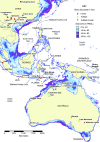When did Homo sapiens first reach Southeast Asia and Sahul?
- PMID: 30082377
- PMCID: PMC6112744
- DOI: 10.1073/pnas.1808385115
When did Homo sapiens first reach Southeast Asia and Sahul?
Abstract
Anatomically modern humans (Homo sapiens, AMH) began spreading across Eurasia from Africa and adjacent Southwest Asia about 50,000-55,000 years ago (ca 50-55 ka). Some have argued that human genetic, fossil, and archaeological data indicate one or more prior dispersals, possibly as early as 120 ka. A recently reported age estimate of 65 ka for Madjedbebe, an archaeological site in northern Sahul (Pleistocene Australia-New Guinea), if correct, offers what might be the strongest support yet presented for a pre-55-ka African AMH exodus. We review evidence for AMH arrival on an arc spanning South China through Sahul and then evaluate data from Madjedbebe. We find that an age estimate of >50 ka for this site is unlikely to be valid. While AMH may have moved far beyond Africa well before 50-55 ka, data from the region of interest offered in support of this idea are not compelling.
Keywords: Homo sapiens; Late Pleistocene; Madjedbebe; Sahul; anatomically modern humans.
Conflict of interest statement
The authors declare no conflict of interest.
Figures
References
-
- Hublin J-J, et al. New fossils from Jebel Irhoud, Morocco and the pan-African origin of Homo sapiens. Nature. 2017;546:289–292. - PubMed
-
- Klein RG. The Human Career: Human Biological and Cultural Origins. 3rd Ed Univ of Chicago Press; Chicago: 2009.
-
- Hoffecker J. Modern Humans: Their African Origin and Global Dispersal. Columbia Univ Press; New York: 2017.
-
- Bae CJ, Douka K, Petraglia MD. On the origin of modern humans: Asian perspectives. Science. 2017;358:eaai9067. - PubMed
Publication types
MeSH terms
LinkOut - more resources
Full Text Sources
Other Literature Sources



